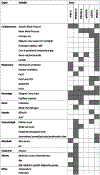Scoring Systems for Organ Dysfunction and Multiple Organ Dysfunction: The PODIUM Consensus Conference
- PMID: 34970683
- PMCID: PMC9703039
- DOI: 10.1542/peds.2021-052888D
Scoring Systems for Organ Dysfunction and Multiple Organ Dysfunction: The PODIUM Consensus Conference
Abstract
Context: Multiple scores exist to characterize organ dysfunction in children.
Objective: To review the literature on multiple organ dysfunction (MOD) scoring systems to estimate severity of illness and to characterize the performance characteristics of currently used scoring tools and clinical assessments for organ dysfunction in critically ill children.
Data sources: Electronic searches of PubMed and Embase were conducted from January 1992 to January 2020.
Study selection: Studies were included if they evaluated critically ill children with MOD, evaluated the performance characteristics of scoring tools for MOD, and assessed outcomes related to mortality, functional status, organ-specific outcomes, or other patient-centered outcomes.
Data extraction: Data were abstracted into a standard data extraction form by a task force member.
Results: Of 1152 unique abstracts screened, 156 full text studies were assessed including a total of 54 eligible studies. The most commonly reported scores were the Pediatric Logistic Organ Dysfunction Score (PELOD), pediatric Sequential Organ Failure Assessment score (pSOFA), Pediatric Index of Mortality (PIM), PRISM, and counts of organ dysfunction using the International Pediatric Sepsis Definition Consensus Conference. Cut-offs for specific organ dysfunction criteria, diagnostic elements included, and use of counts versus weighting varied substantially.
Limitations: While scores demonstrated an increase in mortality associated with the severity and number of organ dysfunctions, the performance ranged widely.
Conclusions: The multitude of scores on organ dysfunction to assess severity of illness indicates a need for unified and data-driven organ dysfunction criteria, derived and validated in large, heterogenous international databases of critically ill children.
Copyright © 2021 by the American Academy of Pediatrics.
Conflict of interest statement
FINANCIAL DISCLOSURE: The authors have indicated they have no financial relationships relevant to this article to disclose.
Figures



References
-
- Straney L, Clements A, Parslow RC, Pearson G, Shann F, Alexander J, et al. Paediatric index of mortality 3: an updated model for predicting mortality in pediatric intensive care*. Pediatr Crit Care Med. 2013;14(7):673–681. - PubMed
Publication types
MeSH terms
Grants and funding
LinkOut - more resources
Full Text Sources

